As stressed earlier, the following points are important to remember:
in the SADC Region, the rural population is poor and malnourished (Section 3.4);
animal proteins are lacking in the diets of rural poor especially. Such a deficiency affects particularly women (periods of pregnancy and breastfeeding - the latter exceptionally long in Africa) and children (early brain development);
extensive areas are suitable for small-scale aquaculture development and numerous small water bodies exist (Section 3.2) where fish production potential and level of production are still very little known;
small-scale fish farming integrated with existing farming systems offers additional opportunities to small holder farmers:
Technology for small-scale production of juvenile and adult fish (in particular tilapias and common carp) in earthen ponds is well known. Extension methodology has been developed during previous ALCOM phases (1987 – 1994) to reach the smallholder farmers.
But, promotion of small-scale fish farming, including the exploitation of small water bodies and its adoption by small holder farmers is a long term process. It requires for each particular geographical area:
There have as yet been no systematic attempts in the SADC Region to enhance the fish production of small water bodies for the small-scale sector. An overall extension approach similar to the one proposed for small-scale aquaculture for assessing, developing and managing their fish production potential is needed to serve the small-scale farmers and communities living nearby.
Aquaculture institutions in the SADC Region do not have the human and financial resources to support aquaculture development. Attempts have been made (ALCOM 1980–1994) and need to be expanded to improve their capacity:
But existing constraints, which are of considerable importance against the development of the small-scale aquaculture sub-sector in the SADC Region, should always be kept in mind:
The previous independent evaluation of the ALCOM Programme (1994) strongly recommended to focus on:
Accordingly, the SIDA Natural Resources and Management Division13 defined a series of special conditions for the use of Swedish funds, such as for example:
Similarly, BADC requested a revision of project document GCP/RAF/277/BEL to take into account the recommendations of the evaluation mission.
In February 1995, the Eighth Steering Committee recommended that future ALCOM activities should:
13 Letter ref. 1.52.15 FAO dated 16 December 1994
Against this background the objectives have been reformulated. There is a general development objectivefor the whole ALCOM Programme, stated in the Terms of Reference of this evaluation mission to “increase cash income and/or animal protein component in the diet of rural communities, achieved through increased production of fish from small-scale aquaculture integrated with suitable farming systems and from improved management of small water bodies.”
The whole ALCOM programme consists of two parts, the Core Programme and the Small-Water Bodies Project:
The immediate objectivesof the Core Programme, as stated in the Terms of Reference are:
In earlier documents these immediate objectives have been referred as “intermediate objectives”, and in the report from the 8th Steering Committee14 they are qualified as “intermediate/immediate” and are related to the whole ALCOM programme!
In reality, the basis for the ALCOM workplans has been the draft project document for ALCOM Phase III15. In this document the above “immediate” objectives are cited as “intermediate objectives”, and other “immediate objectives” are formulated as follows:
There is a close correspondence between the objectives stated in the Mission Terms of Reference and those listed for the Core Programme. The difference is that the latter are adding some management issues, necessary to fulfil the other objectives. The evaluation mission will use these last immediate objectives, when assessing the concrete output of the programme (Section 5.4).
The immediate objectives of the Small Water Bodies Project, as stated in the Terms of Reference, are:
14 ALCOM Report No 20, 1995, p 31
15 GCP/INT/555/SWE, five years programme (1994)
To make an assessment of the validity of the objectives of the programme, some kind of frame of reference is needed, formulated independentlyfrom the project. It should be based on general experiences of development projects, e.g. the way theories of social development articulate them. Here the evaluation team has chosen a socio-economic approach referring to Transfer of Technology, which relates closely to ALCOM's activities.
If the ultimate goal of the project is to improve the livelihood of rural communities by introducing and /or improving existing aquaculture technologyin small ponds or water bodies, “technology” should be seen as a complex concept. The logical structure of this concept (Figure 1) will be discussed next.
Figure 1. Structure of the technology concept

According to Figure 1 the technology concept comprises two main aspects: the technological and the social setting aspects.
(a) Technological aspect
The ALCOM project certainly has paid a lot of attention to the hardware side (1.1) of fish farming, the ponds or the SWB. The tools needed for establishing, maintaining, controlling, harvesting and transporting fish stocks have also been well taken into account.
Sometimes projects are found which have not considered that the software or knowledge (1.2) needed for using the tools is important per se. They make the mistake of taking for granted that the tools are self instructing. ALCOM definitely has not made this mistake. Instead it has focused its interest on the knowledge aspect. A lot of efforts have been put in adapting rather simple knowledge, for example, on how to use ponds, as well as more advanced methods on how to estimate fish populations for optimal harvesting. In fact, this transfer of knowledge has been the focal point, compared to the hardware side. In fact, very little equipment is to be transferred to make the project work.
(b) Social-setting aspect
No technique is working as neutral instrument improving living conditions or generating profits for other means. In classical studies of work, examples are often taken from the car manufacturing industry. The difference between the assembly line technology and the team work technology is considerable, when it comes to work satisfaction and the development of the human resources in the labour force. Considering output, the difference is very small. Very often this social setting, the second main aspect of the technology concept which comes “automatically” with an imported technology, is taken for granted. This means in practice that it is neglected. To introduce a sustainable new aquaculture production system it is necessary to consider this aspect carefully. Is this the case with the ALCOM programme?
Three aspects of the social setting should be successively considered:
ALCOM has devoted much attention to this aspect, both when it comes to information strategies, in order to affect mass media as well as public opinion. Especially when it comes to improved methods for use of SWB, major parts of the programme have been designed to approach problems like social mobilisation, issues on laws, rules and regulations in the local community, cooperation methods, etc., besides the problems of how the increased fish harvest would be brought into the farmer's way of living as a natural part of it.
A formal benefit-cost analysis is not made, but indirectly it can be seen that the outcome would be positive. The costs by and large are limited to the expenses for the extension services to be needed in the future. Land use may be regarded as a very small cost, if the aquaculture activities are not blocking other kinds of use. The integrative approach to the smallholder farmers' other activities, means that there is no opportunity cost for labour, given that fish farming is practised up during periods of slack demand of time from other agricultural activities. Simple equipment is needed for building and maintaining ponds, and sometimes relatively small investments are needed e.g. for nets for efficient harvesting (with depreciation cost over several years). Fertilisation of the small ponds is mostly done with wastes from other household sectors.
The benefits are obvious. Fish addition to the diet of the farming families several times per week is possible even from rather small ponds. Cash income may result from more specialised fisheries (which may be in conflict with the integrative agricultural approach). It should not be difficult to cover the costs or realise returns on the investments.
But there are other kinds of output which should be considered. The fact that people take part in the project promotes change per se, which is generally needed in the modernisation process. Some of these activities are related to entrepreneurship, which should be taken care of and developed by the extension services. If farmers start trading surplus fish, or bartering other kinds of crop to buy more efficient tools (e.g. nets), this may lead to more fish to sell. Sales outside the village necessarily mean that farmers must cooperate in marketing, distribution and other activities. One activity stimulates the development of another. People with entrepreneurship spirit will take these opportunities.
This wider economic approach is reflected in ALCOM's activities, even if the programme leaves some of these aspects such as. entrepreneurship more in the background.
Political and institutional aspect (2.3): Introducing a new system, which is not accepted by the political system - at all levels - is impossible. A new system which is seen as fruitful and considered well worth backing up by the public administration, for example, with extension services, comes close to sustainability. The ALCOM programme has really taken the political and institutional aspects into consideration when designing the project. Every pilot project introduction in the field has been made after appropriate contacts with state and local authorities, and other representatives for the groups concerned about the change. An information system has been developed to influence public opinions as well as public authorities. Information strategies have been designed also to safeguard legitimisation at the regional level. Especially in the small water bodies project, efforts are made to develop a strategy on how best local communities could manage the use of the water bodies.
A general policy of the ALCOM Programme seems to be avoiding establishing structures parallel to the official or local ones. ALCOM has diffused its organisation into the state extension services, not only by supporting them with manuals and institutional support from Harare headquarters and from FAO Fisheries Department in Rome, but also by temporarily paying some key persons (civil servants, such as NPPPs) to work in these extension services. The policy, however, which may make this organisation look a little diffuse, is that long term dependability on donors should be avoided. After introducing the technology the donor-supported ALCOM organisation should be able to close down, hopefully without any open wounds from false expectations.
In the political perspective this may be interpreted as creating self reliance in the areas where aquaculture is introduced or improved. A simple technology, even if it is based on advanced research, should be used not primarily to improve the individual smallholder farmers economy, but rather to improve food security, when times are bad. In this way, farmers will become less dependenton “vertical structures”, i.e. help coming from higher hierarchical levels, either within the country or from foreign donors. At the same time the smallholder farmers will become more dependenton each other, or on other communities sharing the same kind of problems. This is usually defined as “horizontal structures”. In a self reliance perspective, this is considered as a good phenomenon, keeping the less favoured, often peripheral, communities to join together against the more central institutions or groups.
Summing up, it seems that the objectives, as formally stated and as expressed in the practical adaptation of the programme, fit very well to this frame of reference for the transfer of aquaculture technology to smallholder fish farmers. This means that the objectives should be regarded as valid for the technology transfer process. The evaluation team feels confident that no essential parts of this process has not been properly addressed. Little has been said so far, however, about target groups or target areas, except that “rural areas” and that “suitable farming systems” should be selected. Comments on this will be made in the following section on “project design”.
In the formulation of the immediate objectivessome necessary but not sufficient tasks for the project are stated. This is acceptable for practical reasons. The first immediate objective for the Core Programme reflects the fact that there is a project organisation which needs general management and administration as well as project management, besides the field activities. The first part of this first objective states that there shall be “administration and management of the whole programme”; the second part, says that there shall be created “awareness about aquaculture development issues, potentials, and limitations in the member countries in the region.” The second part is not necessarily related to headquarters activities, but seems to be a reasonable task for them. In that case we have a justification for a project structure with both administrative and operative activities.
In practice, the first immediate objective for the Core Programme seems to be the only policy signal that is formulated directly for the ALCOM headquarters activities. The second immediate objective on developing, testing, introducing etc. new aquaculture methods is instrumental and directly related to the field activities in the process of technology transfer.
The third immediate objective is also thought of as referring to field activities, when discussed in the Steering Committee. But, in practice, promoting “increased support from national and local development institutions” will need contacts, information, education as well as negotiations and policy making, which sometimes may occur at rather high level. There are reasons to believe that this is a feasible task for the ALCOM centre.
The small water bodies project immediate objectives are concentrated into three main lines, all three related to field activities. The first is to develop methods for the estimation of fisheries potential. The second concerns assessing the resources of small water bodies for local communities in the SADC region. The third aims at providing feasible methods for management of small water bodies by local communities. All three objectives fit well into the general frame of reference for transfer of technology sketched above. This programme seems to come closer to the “sufficiency” condition, although this is not theoretically proven here.
On the whole the immediate objectives seem to cover the main aspects necessary in a project organisation geared to the transfer of aquaculture knowledge to smallholder farmers and to its integration into traditional agricultural activities. The objectives are strong on the technical aspects, providing the framework for development activities both on the hardware and software sides of the aquaculture technology. The other aspects of the technology concept, regarding the social setting (including cultural, socio-economic and political aspects) are also considered. But, the objectives give very little guidance on how to organise the project work. Is there a preference for a participatory, grass-root initiated and managed, development activity, where the project organisation mainly plays a service role? Or is a more expert oriented, top-down organisation to be preferred? Given that the main purpose is the very abstract task of producing knowledge (on very concrete activities in the field), the results will definitely be different if a top-down based strategy is chosen instead of a bottom-up approach. The following analysis of ALCOM's project design and organisation will investigate how these degrees of freedom have been used when building the “ALCOM Model”.
The evaluation team approach to the “design of the project” will be to apply established methods on how to investigate organisational behaviour when accomplishing a task, in this case the transfer of fish-farming technology to small-holders.
First a general interpretation of the conceptual model behind the project organisation will be presented, where the main “actors” who should be taken into account when promoting fish farming, are identified. The main types of promotion and the relationships between the various actors will be shown and discussed. This section represents the evaluation team's understanding (interpretation) of the ALCOM organisation's basic assumptionson the necessary relationships, which should be taken into account when promoting fish farming.
Then, the organisation of the ALCOM project will be presented graphically, compiled directly from the basic documents of the project. This section intends to give the reader a comprehensive picture of the formalinstitutions of the project. Comments will tell what the evaluation team finds feasible and what needs improvement.
In the third part, the processes which take place within this structure to make the system work will be analysed. These include budgeting processes, workplans elaboration, information flow, decision making processes, etc. Traditional organisational studies give much emphasis on this aspect, when assessing the efficiency of an organisation. Data on the processes have been obtained from interviews with the central actors of the system and from general discussions during field visits.
In recent organisational theories a lot of interest has been focused on “organisational culture”. When it is possible to make all members of an organisation “work in the same direction” by making everyone understand that every task is related to a common recognized and accepted goal, effectivity is usually greater than with a good formal organisation. Developing a common organisational culture within ALCOM has not formally been on the agenda, but of course there have been many informal discussions about the working “climate” of the top hierarchy, the extension workers and the other actors of the system. The evaluation team will also comment upon this aspect. But it does not intend to go deeper into these questions, because little attention has been paid to this aspect so far. The team will rather come back to this subject in the final chapter's recommendations for the future.
Every complex project organisation has an internal organisation which is related to the external context in which it is working. The functions of the internal organisation reflect what is considered as the necessary tasks to accomplish vis-a-vis the actors in this external world.
So, ALCOM's internal organisation is designed to meet what is seen as important issues in the external world. If for example an important task would be to influence the public opinion, ALCOM would design a part of its resources to information dissemination, probably with emphasis on mass media. Other tasks would need other resources in the internal organisation.
It is a straight forward task to evaluate if ALCOM has succeeded or not in using mass media for information dissemination to influence the public opinion. This is, however, what is usually referred to as a simple efficiency-perspective, or checking if ALCOM is “doing the things right”. But a more important question for the evaluation mission is to find out if ALCOM is “doing the right things”. This is usually referred to as an effectivity-perspective.
The effectivity-perspective demands a holistic viewof how ALCOM is supposed to work to accomplish its task, the transfer of fish-farming technology to smallholder fish farmers (Figure 2). There is no holistic model presented by the organisation that shows what ALCOM regards as necessary relations to external stakeholders or other important actors. It is possible, however, to extract such a model from the activities in the project design. In reality, this kind of conception of the relations to the context that governs the organisation's behaviour is very complicated. This means that the model proposed overleaf is oversimplified Hopefully, it will serve the purpose of making the ALCOM model explicit and therefore possible to analyse and criticise.
Figure 2. ALCOM's model for transfer of fish-farming technology to smallholder fish farmers
The boxes in the diagram indicate which actors in the aquaculture field ALCOM has considered most important, and the arrows indicate the relationships between them. The text will clarify the functions that are bound to these relationships.

Knowledge about aquaculture exists in various parts of the world. Especially interesting for the project are the experiences gained in small-scale fish farming in South East Asia. The first arrow (a) indicates that one of the main functions of ALCOM is to bring this kind of knowledge to the SADC Region. The programme should cover this aspect. The best way to do this consists in recruiting foreign experts to develop programmes and initiate activities on research, development, education and training.
The results from these activities are transferred to the Extension Services (b) which in turn organise and train local farmers in aquaculture techniques (c). The farmers, especially the so called contact farmers are supposed to transfer the technology further on to other potential fish farmers in the SADC region in Africa (d).
To support this process of technology transfer, it has also been considered as important that ALCOM uses part of its resources for regional development vis-a-vis SADC, mainly by informing the SADC-observer in the Steering Committee (e). (The arrow points in both directions, because the Steering Committe will also give policy signals to ALCOM.)
From ALCOM's activities it can be seen that the member countries, usually represented by their Ministry of Fisheries or Agriculture (Table 2) are considered as important participants in the process (f). If a government does not support the Extension Services, the transfer process will probably be broken before it reaches the fish farmers (g). The information function in ALCOM's Programme has been developed to meet this need. The importance of the member countries is also emphasised out by its participation in the Steering Committee (h).
ALCOM's relation to the public opinion, normally indirectly via mass media, is also documented in ALCOM's files. The special information function is designed to meet also these needs (i). The importance of this is underlined by the role of the public opinion when influencing the government's reaction to matters on aquaculture (j). Personnel from the Extension Services will be better motivated to perform well, if they are seen as important and interesting actors in the eyes of the public opinion (k). Of course, it is also easier to make a farmer accept a new way of thinking about food security, diversification of crops, farming techniques, etc. if it is already believed that fish farming is a proven method for improving smallholder farmers' livelihood (1).
ALCOM is also spending part of its resources (m) to support non SADC countries with information (Section 3.9.8), which also may positively affect the Steering Committee's decisions on these matters (n).
The model, described in this way, can be used to determine if the internal structure of ALCOM, as presented in the next section, is the best. But first the model itself should be studied. Is this the best way to achieve a fast transfer of fish-farming technology to smallholder farmers, in resource-poor areas of the SADC countries? Maybe some of the actors would be left outside. If, for example, the resources used for information and the government were directly used to promote a more qualified and independent Extension Service organisation, would this lead to faster development? Or maybe much more resources should be allocated to information in the relevant public departments, to encourage them to make their own efforts instead? This would not include any direct relation between ALCOM and the Extension Services in the model. Maybe other actors should be included in the model, such as potential donors to take over the lead until a sustainable transfer process is established? In that case, this function also should be reflected in ALCOM's internal organisation. These questions will be discussed later when assessing the project design (Section 4.3.6).
From 1989 to 1992, ALCOM activities were defined according to nine target areas:
For the implementation of ALCOM Phase III, SIDA has recommended that these target areas (except the last one) be integrated in pilot project design and in training programmes, rather than being treated separately.
Following an internal review in 1992, these target areas became grouped, into four action programmes:
Due to limited funding, priority was given in 1993–94 to Action Programmes 1, 3, 4 and to Information (AP 2 partim.)
The 1994 evaluation recommended that ALCOM focuses on the development and dissemination of methodologies for smallholder aquaculture integrated with farming practices and on the utilisation of small water bodies (enhancement/management)
In addition, SIDA has insisted that core programme pilot projects be implemented in Mozambique, Tanzania and Zambia (letter from SIDA/NRM to FAO dated 16 December 1994)
During Phase III, the ALCOM Programme has therefore been structured as follows:
(a) Regional Activities (Core Programme - financed by Sweden)
Three regional work programmes, executed from Harare Headquarters:
(b) Core Programme Pilot Projects (Sweden funded)
In addition to these regional activities, the core programme aims at the development of fish culture methodologies integrated with existing farming systems. For this purpose, four sub-national pilot aquaculture projects have been designed in Mozambique, Tanzania and Zambia according to the priority criteria set by Sweden:
(c) Small Water Bodies Project (Belgium funded)
Within this project one regional and four sub-national pilot projects have been designed.
At present, ALCOM staff consists of professional and general service staff (Section 3.9.8). Implementation of pilot projects is executed in close collaboration with nationally contributed fisheries professionals assisted by staff members of sub-national fisheries units. Extension services of Agriculture Departments (sometimes informally), sub-contracted consultants and day labourers also play an important role in the implementation of ALCOM activities.
The ALCOM programme is supported through technical backstopping by FAO, the executing agency (Section 7.2). It operates under the guidance of a Steering Committee, composed of delegates from each of the SADC countries, the donor agencies and FAO (Section 3.9.8). This committee guides and approves the planned activities through yearly meetings.
The following figures (Figures 3 to 8) illustrate this organisational structure, in terms of actual staff used and geographical distribution. According to the logics of the project design (Section 4.3.2), ALCOM is not working as an isolated organisation. Instead it is preparing on various levels institutions in the SADC member countries to take over its activities as soon as feasible. This means that ALCOM's organisation should be analysed both in terms of its own independent units and in terms of the external organisations temporarily supported by ALCOM.
Figure 3: Overall structure of ALCOM in the SADC Region
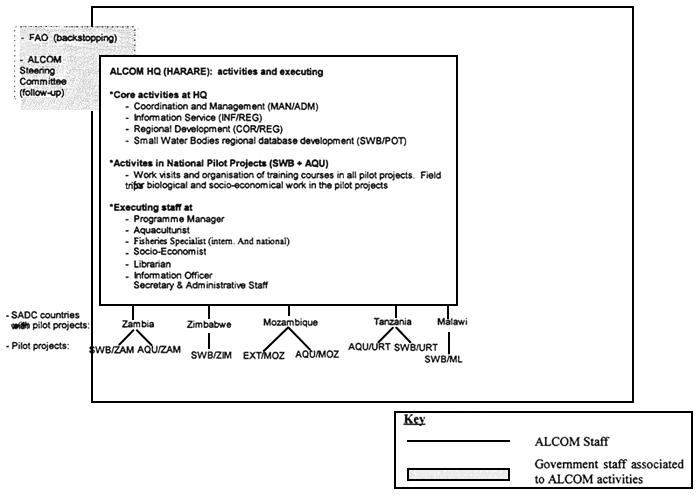
Figure 4: Formal structure of ALCOM's organisation in Zambia. Cooperating units from national administration are shown in light grey.
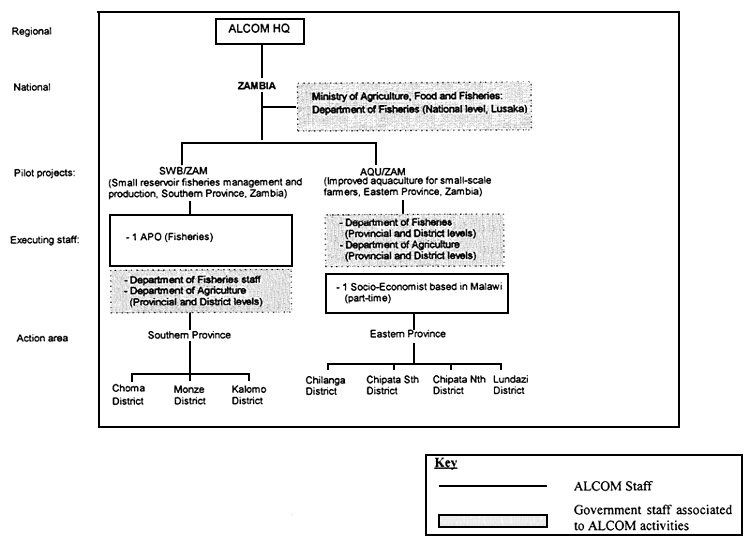
Figure 5: Formal structure of ALCOM's organisation in Zimbabwe. Cooperating units from national administration are shown in light grey
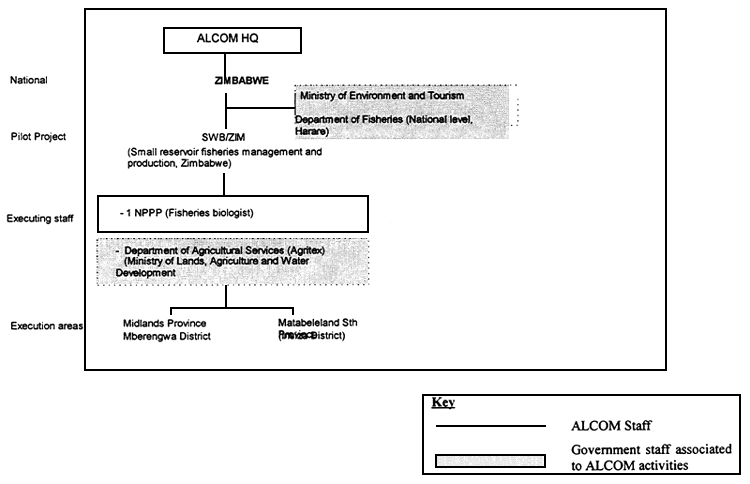
Figure 6: Formal structure of ALCOM's organisation in Malawi. Cooperating units from national administration are shown by dotted lines.
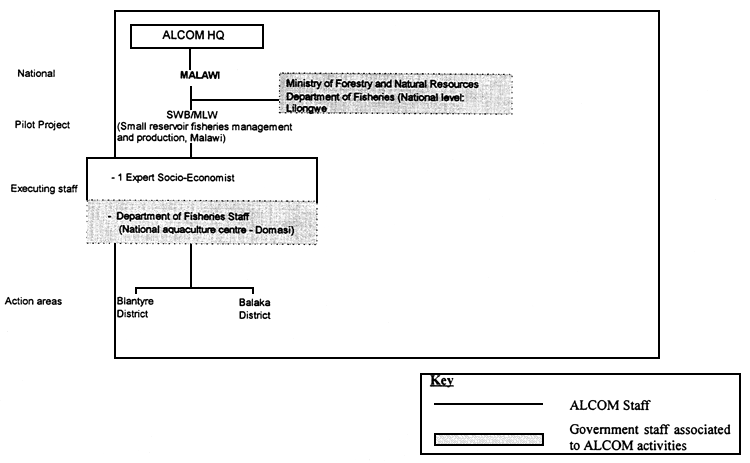
Figure 7: Formal structure of ALCOM's organisation in Tanzania. Cooperating units from national administration are shown by dotted lines.
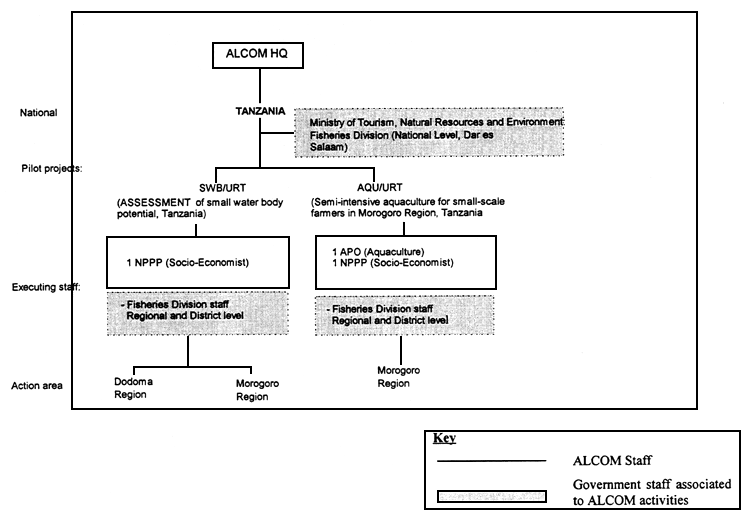
Figure 8: Formal structure of ALCOM's organisation in Mozambique. Cooperating units from national administration are shown by dotted lines.
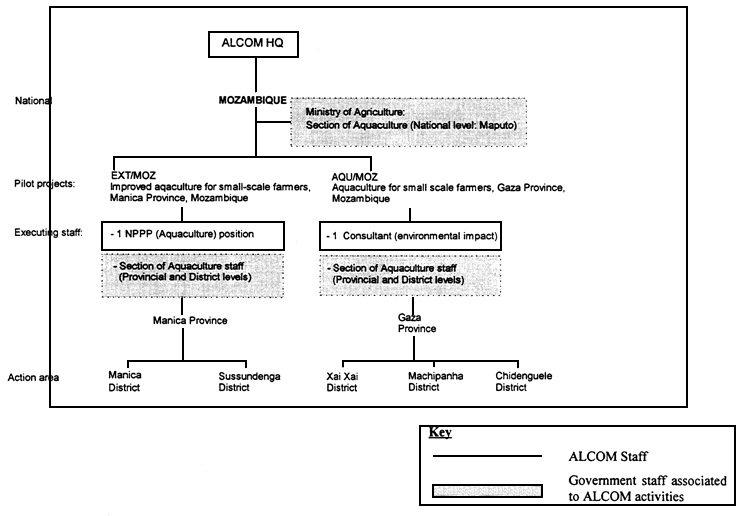
The main instrument for decisionsmaking in ALCOM consists in the process of making workplans (Figure 9). These are supposed to address the whole programme, including core activities in headquarters and pilot projects for aquaculture and small water bodies.
Initiatives for the activities originate from the top of the organisation, sometimes with inputs from grass-root level. Given that the organisation is aimed at improving surveying methods, testing ideas, elaborating pedagogical methods for training, etc., one should not expect that these kinds of initiatives would come from the base levels of the organisation to a greater extent. This does not necessarily mean that the organisation is strongly centralised, but it indicates that headquarters and the Steering Committee (through its Working Groups) represent an important part of ALCOM as far as decision making is concerned.
Figure 9. Decisionsmaking processes for the elaboration and implementation of annual workplans
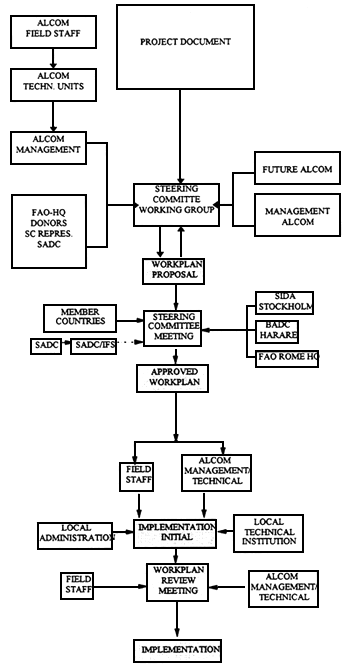
Implementation of workplans are made in the field organisation with a large degree of freedom. The activities are followed up in the budget (Figure 10) and they are executed by specialists in headquarters (project coordinators) in close contact with the field organisation.
There are very few levels of decisionmaking, which makes it possible to process decisions very fast, within the general economic frame of the project. This concerns only the execution of decisions within the frame given by workplans and budgets. Changing this frame is a much more formalised decisionmaking process related to the member countries' system, FAO and the international donors' system. To formulate new objectives, to redistribute economic resources from one headline to another, or to close down a pilot project in favour of the others, requires a very complicated and time consuming process.
Figure 10. Annual budgeting process
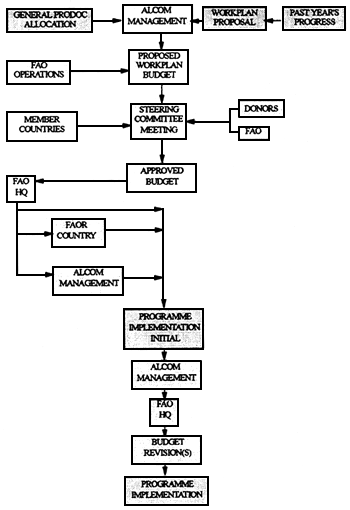
The budgeting process (Figure 10) is of the traditional kind, often called “marginal budgeting”. Given the main lines of the budget from earlier periods (Project document), adjustments are made yearly and follow-up twice a year. Several of the initiatives come from the central parts of the organisation, for similar reasons as were mentioned for the workplans and their implementation. This means that the budgeting process is not too time-consuming.
At field level, the potential influence, within the limits of the workplans, is very large. During the field visits, however, the evaluation team has found that this is not put in to use to the extent which would be expected, for example (by extension service officers).
The information processes of ALCOM (Figure 11) is much more complicated than the formal structures seem to indicate.
There is no ready made package on how smallholders should farm their fish, to be disseminated to extensions services, farmers and other relevant persons. Instead the information service consists of a complex spectrum ranging from the “mechanical” distribution of newsletters, to compilation of accessible information from foreign countries and research within the SADC countries, as well as from the ALCOM pilot projects etc. These activities are most important, seen in the logics of ALCOM's way of working: exchanges of information with regional and governmental levels are as important as meeting the needs from extension services. To some extent, material is also assembled, produced and transferred to the smallholder farmers.
Such activities mean that one should be able to “talk Latin” with researchers, as well as adapting to the farmers way of speaking. Personnel engaged in information activities must also be able to use available means for communication such as surface mail, telephone, fax, and e-mail. Figure 11 demonstrates the “spider role” chosen by ALCOM for the information system on aquaculture and related activities.
Figure 11. Information processes in relation to ALCOM's activities.
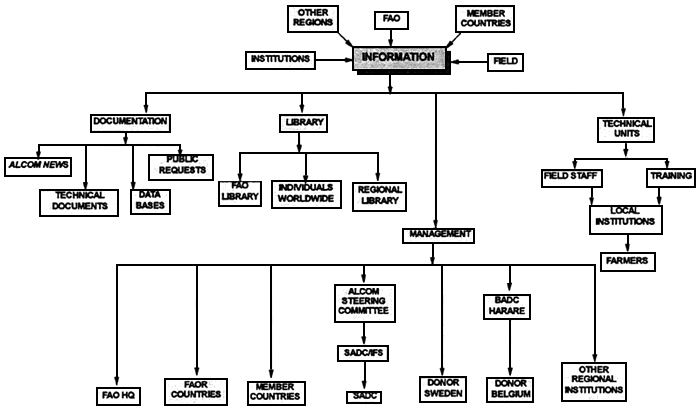
As mentioned above recent organisational theories give much attention to organisational culture. Creation of a “team spirit” in a small organisation usually improves efficiency much better than making job descriptions and detailed workplans for all employees. Creating images for the products, both goods and services, tools as well as knowledge, usually affects the market behaviour or the recipient organisations more efficiently than strict information. Anybody who has been involved in marketing knows this well. But it is not always recognised when it comes to influencing central or local government organisations.
There is a set of four concepts which are often used when analysing organisational culture:
(a) Myth Concept
A myth is sometimes associated with a slightly negative meaning like not being really true, a saga or just a poem. In the sociological literature, however, it is more perceived as a vision and in business administration it actually corresponds to a business plan. In common culture, there also exist many positive myths. The most well known is probably “the American dream”, stimulating millions of Americans to individual efforts even if it is not necessarily true that every American citizen can become either president or at least millionaire by working hard enough.
A close look at ALCOM's organisation shows that many documents, photos on the office walls, general impressions from everyday talks as well as officially published newsletters promote something that may be described as a myth. This is the myth of the wealthy smallholder farmer who has already realised the opportunity of rapidly improving his diet and/or his income by investing small efforts in fish farming
This positive myth probably stimulates the recruitment of new fish farmers; it also justifies the involvement of Government and other organisations.
(b) Symbols within the organisation
For example, logos are defining the domain of ALCOM on letterheads, reports, etc. but also on specific briefcases to carry educational and other materials to the extension services. The special “African look” and artistic original drawings made for ALCOM's newsletters, manuals and other information material are other symbols.
(c) Special status creating mechanisms
The most common among these mechanisms is usually called the “scientification process”. Conventional wisdom or practical experience are justified in scientific or science like operations. In this way, it seems that some rather simple management procedures and fish-farming techniques are approved by advanced research activities. In this perspective, the computer is not only a practical tool for storing and processing rather simple data from creel surveys. It is also, the “science machine” which makes the results “true” to the villagers. Other similar examples are easy to find in the culture of ALCOM.
The international bureaucratic system with donors, FAO, and various NGOs is functionally important in terms of connecting resources. However, it also puts a heavy formal burden on the organisation. A well and consciously positioned organisation in such a system also serves as a status-creating mechanism, important for good promotion of the general myth.
(d) Professionalism
The most important mechanism to create professional identity is the language, which unites the professionals. In this way we can see that ALCOM has created a language cultureshared with other professionals with which it wants to be associated, such as Agritex and others. Every in-group member knows what “small water body” means, what is being done on “awareness courses”, how intensive “semi-intensive fish farming” is, what is the reality behind “participatory rural appraisal” and “community-based management”.
Sometimes one feels that there is a very long mental distance between the advanced paperwork and the reality at the reservoir and the small fish ponds. The professional culture in ALCOM is obviously also a “paper culture”. This is partly explained by the academic research character, of course, and by the bureaucratic relations with FAO; but not all paperwork can be explained in this way because the overall objective is practical improvements in private economies and nutrition. The most reasonable way to interpret the paper flood is that it is part of the necessary professionalisation, to keep the myth alive.
Assessment of ALCOM's “Corporate culture”
ALCOM has evidently created a culture which is very positive for stimulating general interest in fish culture as an integrated part of smallholder farmers' agricultural and other activities. To mobilise resources from government and the local organisations, as well as from NGOs and other potential organisations with interest in rural development in less developed areas, the “scientificated professionalism”-approach may be the most feasible. The myths created on the rather simple techniques to be implemented to obtain substantial returns in terms of food security, improved income etc., seem not to be questioned by anyone. The farmers have adopted the philosophy as well as the appropriate ministries responsible for the provision of the necessary extension services.
Members of ALCOM's professional group, that is the headquarters staff and the field staff, work as well as externally financed persons in the extension services connected to the pilot projects. They seem to have developed a reasonably good “we-feeling”. (This is definitely not the same as equality.) While communication outside the group is sometimes formalised and very often done in writing, the in-group communication is informal and open-minded. This is the basis for good team-work.
A strong group with the “heavy-weight champions” at headquarters and professional contacts/control with the field projects seems to be a condition for keeping up the vision of ALCOM. In this perspective however, it would be interesting for the future to see a more strategic culture policy as one of the management tasks, explicitly expressed in actions.
A simple SWOT model will be used to assess ALCOM's organisation., as described above: simple assessments will be made of ALCOM's Strong and Weak points, as well as of external Opportunities for and Threats to its organisation.
Strong points of ALCOM's organisation
ALCOM is a project which has been active for several years. This means that there have been opportunities to work out routines, relations etc., which are more stable than the persons who occupy the roles in this system. The organisational structure is large enough to comprise a critical mass of professional and administrative personnel to keep up institutional functions. This is strengthened by a powerful organisational culture.
The organisation has a heavy centre and a slightly larger base made of the field organisation. There are few formal levels which facilitates decisionmaking when it comes to implementing decisions originating from above. This top-down oriented organisation with a heavy centre, a lean middle, and a large base is usually considered to be very efficient. It is typical for professional research and development organisations.
The structure of the information system is very well developed and the means for communication are advanced.
Weak Points of ALCOM's organisation
The lack of bottom-up perspective is on the other hand a handicap for mobilising local communities, which is an essential task of ALCOM's activities. For example, this may result in less motivated extension personnel. The informal way of cooperation between headquarters and the field, partly compensates for this.
The informal decisionmaking is only relevant when it comes to the relations between headquarters and the field activities. For the relations with SADC and FAO, there is a time consuming paper culture in a rigid decisionmaking process. Given that two supranational systems, FAO/donors and SADC, should be considered simultaneously, there is little chance for radical changes, even if they are urgently needed.
The budgeting process too is adapted to marginal changes only. If ALCOM would work according to modern management principles on “learning organisations”, a much more flexible budgeting process adaptable to radical changes of immediate objectives and activities would have to be implemented.
Opportunities for ALCOM's Organisation
Aquaculture will definitely expand in the future, with or without ALCOM's intervention, inside and outside Africa. This makes the scope of possible future activities open to new creative ideas.
With ALCOM representing a very wide web of contacts, especially for information, new ideas should easily come into the system. This is especially true because the technical staff in ALCOM Headquarters in reality includes several qualified researchers representing various disciplines and national origins.
Threats to ALCOM's organisation
The kind of activities ALCOM performs is representative of more advanced societies (post industrial societies), which are based on service activities. Public investments in advisory service organisations always pay off when they result in increased productivity in various sectors of the society. Benefits will come as increased taxes and/or decreased subsidies.
Overall assessment of the whole programme design
ALCOM has a reasonably transparent organisational structure with rigid bureaucracies for controlling it at the top and a more flexible headquarters having informal relations with the field organisation. There are few formal levels, so that this organisation should be considered as providing possibilities for efficient activities to fulfil its objectives. The next chapter will analyse if the output is in accordance with these conditions.